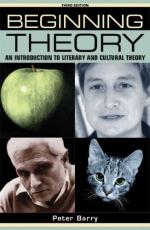|
This section contains 419 words (approx. 2 pages at 400 words per page) |

|
Beginning Theory: An Introduction to Literary and Cultural Theory Summary & Study Guide Description
Beginning Theory: An Introduction to Literary and Cultural Theory Summary & Study Guide includes comprehensive information and analysis to help you understand the book. This study guide contains the following sections:
This detailed literature summary also contains Topics for Discussion and a Free Quiz on Beginning Theory: An Introduction to Literary and Cultural Theory by Peter Barry.
Peter Barry's 290 page "Beginning Theory: An Introduction to Literary and Cultural Theory" is first published in 1995 with a Second Edition in 2002. This non-fiction and quasi-historical text provides an introduction to more than a dozen literary and cultural theories from liberal humanism to twentieth century ecocriticism. The author is an English Professor at the University of Wales in Aberystwyth, Wales, UK where he teaches several theory courses. Barry becomes aware as an undergraduate at London University in the1960s that instruction in literary theory is deficient. The first course in literature then is "Beowulf to Virginia Woolf." He writes this book to cure a deficiency from his undergraduate studies and to close that gap for new students of literature.
As a result, Peter Barry writes this introductory book to satisfy student learning needs rather than to exhibit novelists' writing styles. Since his undergraduate study of the "wolves" left him uninspired he writes "Beginning Theory" to inspire today's students to explore and find interest in literature of all types. One way Barry accomplishes this goal is with practical activities like regular "STOP and THINK" sections for readers to make "some personal sense of theory." His style of writing is subjective to offer a friendly, understanding and straightforward presentation of literary and cultural theory. He writes as if he is speaking to a small group of students on a subject he thoroughly understands, participates in and enjoys.
"Beginning Theory" is detailed and specific enough to provide ready reference to the subject matter. For example, a reader who wants to know how a stylistic critic differs from a post-structuralist critic can find both identified by name and page number on the Contents page. Barry's literary critiques at the end of each chapter illustrate specific, practical examples of how that literary theory can be applied. This text is an excellent learning tool for a beginning or advanced student of literary and cultural theory. It is presented in an organized and well-defined manner. Barry's writing is clear, concise and informative, providing useful, relevant, yet not excessive or extraneous knowledge about the history and styles of literary criticism.
Barry shares the enthusiasm he has for literature with his readers. He uses layman's words where possible to help the reader understand difficult concepts. The reader is reassured by his writing style, approach and terminology that concepts can be understood and interesting. For example, Barry's goal in writing this book is clear in his statement, "Above all, it aims to interest you in theory."
Read more from the Study Guide
|
This section contains 419 words (approx. 2 pages at 400 words per page) |

|



